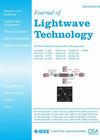Wavelength Dependence of Spatial Mode Dispersion in High-Density Randomly Coupled Multi-Core Fiber Cables
IF 4.8
1区 工程技术
Q2 ENGINEERING, ELECTRICAL & ELECTRONIC
引用次数: 0
Abstract
We experimentally and numerically investigate the spatial mode dispersion (SMD) characteristics of randomly coupled multi-core fibers (RC-MCFs) in high-density optical cables. Our experimental results show that cabling tends to reduce both the absolute value and the wavelength dependence of SMD, regardless of the number of cores and refractive index profiles of the RC-MCFs. Heat-cycle tests with temperature variations ranging from –30 °C to +70 °C indicate that SMD variations due to temperature changes remain within 1 ps/高密度随机耦合多芯光缆中空间模色散的波长依赖性
实验和数值研究了高密度光缆中随机耦合多芯光纤(rc - mcf)的空间模色散特性。我们的实验结果表明,无论rc - mcf的芯数和折射率分布如何,布线倾向于降低SMD的绝对值和波长依赖性。温度变化范围从-30°C到+70°C的热循环试验表明,在S-L波段,温度变化引起的SMD变化保持在1 ps/$\sqrt {\text{km}} $范围内。采用2芯模型进行的数值模拟表明,SMD的波长依赖性与电缆中最频繁弯曲半径处耦合系数的波长依赖性相关。这些结果表明,通过同时优化芯距、扭率和模弯曲半径,可以降低高密度电缆中RC-MCF对SMD波长的依赖性。
本文章由计算机程序翻译,如有差异,请以英文原文为准。
求助全文
约1分钟内获得全文
求助全文
来源期刊

Journal of Lightwave Technology
工程技术-工程:电子与电气
CiteScore
9.40
自引率
14.90%
发文量
936
审稿时长
3.9 months
期刊介绍:
The Journal of Lightwave Technology is comprised of original contributions, both regular papers and letters, covering work in all aspects of optical guided-wave science, technology, and engineering. Manuscripts are solicited which report original theoretical and/or experimental results which advance the technological base of guided-wave technology. Tutorial and review papers are by invitation only. Topics of interest include the following: fiber and cable technologies, active and passive guided-wave componentry (light sources, detectors, repeaters, switches, fiber sensors, etc.); integrated optics and optoelectronics; and systems, subsystems, new applications and unique field trials. System oriented manuscripts should be concerned with systems which perform a function not previously available, out-perform previously established systems, or represent enhancements in the state of the art in general.
 求助内容:
求助内容: 应助结果提醒方式:
应助结果提醒方式:


